Carolands
Carolands Chateau is a 46,050-square-foot (4,278 m2),[20] 4.5 floor, 98 room mansion on 5.83 acres (2.36 ha) in Hillsborough, California. An example of American Renaissance and Beaux-Arts design, the building is a California Historical Landmark and is listed on the National Register of Historic Places. Carolands is one of the last of the houses built during the Gilded Age, a period of great mansion-building that included famous houses of the Vanderbilt family, such as Marble House, Biltmore Estate and The Breakers, and stately California houses such as Filoli and the Huntington family's mansions.
| Carolands Chateau | |
|---|---|
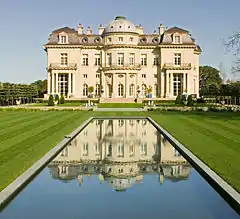 West façade, 2006 | |
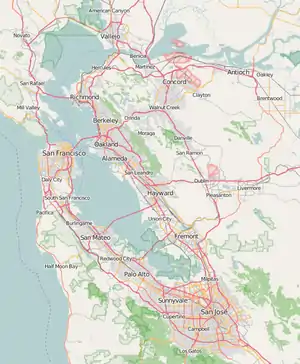 Carolands Location within San Francisco Bay Area  Carolands Carolands (California)  Carolands Carolands (the United States) | |
| Alternative names | Carolands, Remillard Manor, The Chateau |
| Etymology | Harriett Pullman Carolan |
| General information | |
| Architectural style | Beaux-Arts Classicism |
| Address | 565 Remillard |
| Town or city | Hillsborough, California |
| Country | United States |
| Coordinates | 37°33′19.8″N 122°22′14.7″W |
| Groundbreaking | 1914 |
| Completed | 1916 |
| Renovated | 1998–2002 |
| Cost | est. US$1,000,000 (equivalent to $25,273,026 in 2019)[1] |
| Renovation cost | est. US$20,000,000 (equivalent to $28,429,232 in 2019)[2] |
| Owner |
|
| Height | 100 feet (30 m)[13] |
| Dimensions | |
| Other dimensions | 130 feet (40 m) x 120 feet (37 m)[13] |
| Design and construction | |
| Architect |
|
| Renovating team | |
| Renovating firm | Doug Wilson[17] |
| Other designers | Mario Buatta |
| Other information | |
| Number of rooms | 98 |
| Website | |
| carolands | |
Carolands | |
| NRHP reference No. | 75000478[18] |
| Added to NRHP | October 21, 1975 |
| Official name | Carolands |
| Designated | 9 May 1975 |
| Reference no. | 886[19] |
History
Harriett Pullman Carolan
The woman who built Carolands, Harriett Pullman Carolan (1869–1956), was the daughter of George Pullman, a 19th-century industrialist, one of Chicago's wealthiest men, and founder of the Pullman Company, famous for its Palace railway cars. In Chicago in 1892, Harriett Pullman married Francis Carolan of San Francisco and moved with him to California. In 1912, she acquired 554 acres (224 ha) of land in Hillsborough,[21] on which she intended to build a house and garden that would excite "the wonder and admiration of America" and reflect her many refined and cultivated interests.[22] The result was a masterpiece of Beaux-Arts architecture, inspired by the court architecture of Louis XIV. Carolan chose the site, the highest in the neighborhood, for its commanding views of the San Francisco Bay and the surrounding hills.
Architects
Harriett Carolan commissioned plans for the chateau from the Parisian architect Ernest Sanson, at the time France's foremost designer of prestigious private houses. Sanson was a classicist, and his design for the chateau's exterior was inspired by the 17th-century designs of François Mansart. He was seventy-six years old, near the end of a long and distinguished career, and never visited the California site. Carolan engaged the San Francisco-based Willis Polk, a distinguished architect in his own right, to be the structural designer and construction manager, instructing him to faithfully execute Sanson's designs.[23]
France's leading landscape architect, Achille Duchêne, designed Carolands' gardens. Duchêne's work was inspired by the works of the great 17th-century landscape designer André Le Nôtre, whose most famous creations included the gardens at the Palace of Versailles, Vaux-le-Vicomte and the Jardins des Tuileries. In his original, ambitious design for Carolands, Duchêne planned miles of roadways leading across extensive grounds, landscaped with thousands of shrubs and trees, accented by fountains and statuary. Only a small portion of the scheme was ever built.
Construction
Soon after Harriett Carolan secured the land in 1912, Duchêne arrived in San Francisco to lay out the grand parterre gardens. In late 1913, Ernest Sanson began to design the house. His plans included a dry moat around two sides of the house, discreetly located to provide light and air, and access, to the service spaces in the basement, while not blocking views of the gardens from the principal rooms on the main floor. In his design, Sanson incorporated three 18th-century period rooms that Carolan had purchased in Paris with the advice of the famous antique dealer Boni de Castellane.
In 1914, Willis Polk began grading the great terraces planned by Duchêne, sending progress photographs to the architects and to the owners. Polk began to build the reinforced concrete superstructure he had designed, creating the infill walls with brick, finishing them with concrete stucco, sanded and scored to resemble natural limestone.[24]
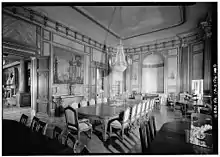
In mid-1916, the elaborate interior elements began arriving on the site. The house as completed had ninety-eight rooms, including nine bedrooms and baths for the owners and their guests, each with an antechamber to guarantee quiet and privacy. The service spaces were equally elaborate: a kitchen with walls and ceiling made of white glass tiles; a service elevator connecting all floors; and a butler's pantry and mezzanine with walls of Delftware tile.[24] In the fall of 1916, Harriett and Frank Carolan moved in with their staff.
First decline
Harriett Carolan did not use her house for long: she separated from Frank Carolan in 1917 and closed the chateau the following year. After the separation, she moved to New York City, while Frank remained in California where he died in 1923. Two years later, Harriett married Col. Arthur Schermerhorn, and while the couple occasionally occupied Carolands, in 1928 Harriett removed her furniture and put the property up for sale.
The U.S. Government considered buying Carolands to use as a Western White House in 1939,[25] and again during the Kennedy administration, but both times declined to purchase.
In 1945, Tomlinson Moseley bought the house and surrounding 550 acres (2.2 km²) from the Schermerhorns and began to sub-divide the land and build additional houses.[3] In 1947, Life Magazine published an article about a charity event held at the house,[26] the first opportunity for San Francisco-area residents to see its interior. According to the article, the house had been abandoned for twenty-five years, so that plumbing for the event had to be provided by a fire hose, and lighting required the use of portable generators and flood lights.
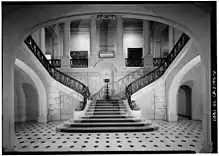
In 1948, Moseley sold the property, by then reduced to 25 acres (10 ha), to Mrs. S. Coe Robinson.[3] By 1950, she had carved off much of the remaining land into smaller parcels and begun to contemplate demolishing the house.[4]
Countess Lillian Remillard Dandini
Countess Lillian Remillard Dandini purchased Carolands Chateau in 1950,[8] saving it from demolition by speculators interested in developing the land, and uninterested in the house's architectural significance. Prior to her marriage in 1932 to Mexican-born Count Alessandro Dandini di Cesena, Lillian Remillard was an heir to the Remillard Brothers fortune, which derived from a brick manufacturing business dating back to California's gold rush, a business that benefitted greatly from the construction boom following the 1906 earthquake. During the twenty-three years (until her death) that she lived at Carolands, the countess entertained often and made the house available for numerous charity benefits. She frequently invited San Francisco's French community to the house and opened it annually to the San Francisco Bay area's French students. Her generosity in sharing the house inspired the Town of Burlingame to give her the town's "Woman of the Year" award.
In her later years the Countess Dandini lacked the necessary funds to maintain the house, and after she died in 1973 it was once again at risk of demolition.[27] The countess willed the house and the remaining 5.83 acres (23,600 m2) to the Town of Hillsborough to be used as a French and Italian musical, artistic and literary center,[28] but was unable to include an endowment. The Town of Hillsborough declined the gift, ruling the proposed use inconsistent with the town's charter while noting it could not afford to pay the cost to maintain the property.
Years of decline
In 1975, the house was added to the list of California Historical Landmarks (CHL #886),[19] and to the National Register of Historic Places (NRHP #75000478).[3] Nevertheless, Carolands suffered from frequent changes in ownership after Countess Dandini's death.
In 1976, Dr. Selwyn McCabe won the house in a probate auction,[5] but declined to purchase, deferring to the next bidder, Rose 'Roz' Franks.[6][7] In 1979, Franks lost the house to George I. Benny,[8] who in turn lost it to foreclosure in 1982, after conviction for conspiring to defraud institutional lenders.[9] At the time, adult filmmakers gained access to the site where they produced the 1982 film All American Girls.[28][29]
During these years, Carolands was often vacant, and curious local high school students often entered the house.[30] In 1985, David Allen Raley, a security guard, lured two high school students onto the property where he sexually assaulted and stabbed them, leaving them for dead in a ravine near San Jose.[31] They managed to climb out of the ravine and flag down a passing motorist for help, but one later died of wounds received during the ordeal.[32] Raley had bragged earlier that day that he often received bribes from curious students interested in the mansion's interior, but that "he only let girls in."[33] He was convicted, and received the death penalty in 1988.[34]

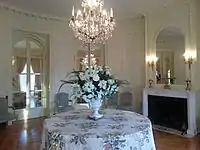
In 1986, Michael DeDomenico, an heir to the family controlling Rice-a-Roni and Ghirardelli, bought Carolands,[12] and that year developers commissioned an Environmental Impact Report in support of a proposal to further subdivide the land and build additional houses. In 1989, the house suffered superficial damage in the Loma Prieta earthquake leading its owners to consider demolishing it. In 1997, a new owner proposed carving the house into fifteen condominiums,[35] but the Hillsborough town charter banned multi-family residences.
Restoration
In 1991, the Hillsborough Designer Showhouse was held at Carolands, attracting 68,000 visitors, each paying $20 admission, netting more than $1 million for the sponsoring charity and reviving interest in the house.[11][36][28][27] Among the visitors were Dr. Ann Johnson, who would later buy Carolands, and her interior decorator, Mario Buatta, who would help her to restore it.
In 1998, Johnson and her husband, Charles Bartlett Johnson, bought the house and the remaining land for under $6 million.[28] Dr. Johnson undertook extensive renovations: repairing the mechanical systems; removing asbestos; replacing the roof; and meticulously restoring the interior finishes, to bring the house back as much as possible to its original condition. Like the Countess Dandini, the Johnsons often shared the house for charity fundraisers and other worthy causes. Their primary purpose in purchasing and renovating Carolands was to preserve it for future decades.[37]
Current status
In 2012, the Johnsons donated the house to Carolands Foundation, which conducts small group tours without charge, as described at their website.[38]
Images of Carolands
Exteriors
 Carolands Chateau: North Façade showing the distinctive dome on the West Façade 2013
Carolands Chateau: North Façade showing the distinctive dome on the West Façade 2013 Carolands Chateau: West Façade from the gardens in the Morning Sun 2013
Carolands Chateau: West Façade from the gardens in the Morning Sun 2013 Carolands Chateau: South Façade with Porte-cochère gates 2013
Carolands Chateau: South Façade with Porte-cochère gates 2013 Carolands Chateau- from Rose Garden Terrace 2013
Carolands Chateau- from Rose Garden Terrace 2013 Carolands Chateau: Interior Porte-cochère
Carolands Chateau: Interior Porte-cochère
Gardens
 Carolands Chateau- South Front Garden view -2013
Carolands Chateau- South Front Garden view -2013 Carolands Chateau- Garden view West from Bordeaux Salon 2013
Carolands Chateau- Garden view West from Bordeaux Salon 2013 Carolands Chateau- West Garden and fountains from Harriett's Bedroom balcony 2013
Carolands Chateau- West Garden and fountains from Harriett's Bedroom balcony 2013 Carolands Chateau- Duchêne Border Parterre 2013
Carolands Chateau- Duchêne Border Parterre 2013 Carolands Chateau- Entry Courtyard view across Gardens 2013
Carolands Chateau- Entry Courtyard view across Gardens 2013 Carolands Chateau- West Terrace and Sphinx 2013
Carolands Chateau- West Terrace and Sphinx 2013
Interiors
 Carolands Chateau: Grand Staircase after restoration
Carolands Chateau: Grand Staircase after restoration Carolands Chateau: Upper Gallery and Main Staircase
Carolands Chateau: Upper Gallery and Main Staircase
Media
In 2006 a feature-length documentary, Three Women and a Chateau, which tells the nearly 100-year history of Carolands, premiered at the Santa Barbara International Film Festival and was featured in seven other film festivals, winning Best Documentary (Grand Jury Award) at the Rhode Island International Film Festival.[39]
The Heiress and Her Chateau: Carolands of California, a one-hour documentary about the chateau, first premiered January 19, 2014 on KQED-TV, and the following year was broadcast nationally on PBS. It was nominated for two Emmy Awards: Outstanding Achievement – Cultural/Historical Documentary and Outstanding Achievement - Writer. Both documentaries were made by Luna Productions.
References
Notes
- Lacy-Thompson, Tony (19 January 2014). "A visit to the Downton Abbey of the San Francisco Peninsula". Regarding Arts. Retrieved 19 March 2015.
- Skurman, Andrew (July 2007). "American Landmark — Book Review: Carolands". Period Homes. 8 (4). Retrieved 19 March 2015.
- Turner, Paul V.; Eliassen Jr., John Weld; Ringler, Donald P.; Von Homola, Beatrice (7 April 1975). "National Register of Historic Places Inventory — Nomination Form: The Carolands" (pdf). United States National Park Service. Retrieved 7 March 2016.
- "Silver and Gold Fittings Offered". Spokane Daily Chronicle. AP. 24 January 1950. Retrieved 19 March 2015.
- "There is a doctor in the 110 room house". The Milwaukee Journal. 27 January 1976. Retrieved 19 March 2015.
- "Chateau Option Dropped" (PDF). The Times. San Mateo. 6 February 1976. p. 10. Retrieved 20 March 2015.
- "Hillsborough's Carolands Sold To Woman Investor". Santa Cruz Sentinel. 9 April 1976. Retrieved 20 March 2015.
- Richter, Judy (11 July 2007). "The House on the Hill: After four years and $20 million, the famed Carolands mansion is set for another century". San Francisco Chronicle. Retrieved 19 March 2015.
- "A California developer has offered $47.2 million for properties ..." UPI. 29 December 1983. Retrieved 20 March 2015.
- "Pasta heir defends self in tax case". The Bend Bulletin. 18 September 1991. Retrieved 19 March 2015.
- Lew, Julie (19 September 1991). "A Mansion Is Restored And Opens As Exhibit". the New York Times. Retrieved 19 March 2015.
- "Carolands chateau rescued by scion of chocolate fortune". Preservation News. December 1986. Retrieved 19 March 2015.
- Wilson, Marshall (28 February 1997). "Preserving A Landmark Mansion". San Francisco Chronicle. Retrieved 19 March 2015.
- "Newsletter". California Heritage Council. May 2009. Retrieved 19 March 2015.
- "Developer to Buy Carolands Chateau". San Francisco Chronicle. 25 January 1997. Retrieved 19 March 2015.
- King, Dale; Hebert, Julia (Summer 2014). "America's Downton Abbey: Chateau Carolands". South Florida Opulence. Archived from the original on 17 August 2014. Retrieved 20 March 2015.
- Michelson, Alan (2015). "PCAD id 9688". Pacific Coast Architecture Database. Retrieved 19 March 2015.
- "National Register Information System". National Register of Historic Places. National Park Service. March 15, 2006.
- "Carolands". Office of Historic Preservation, California State Parks. Retrieved 2012-10-14.
- "Bay Area Behemoths". Curbed.com. 2015. Retrieved 10 September 2015.
- "History". Carolands Foundation. 2015. Retrieved 19 March 2015.
- Price, Paul (March 2008), "Carolands Hillsborough, California", Architecture, p. 2
- Price, Paul (March 2008), "Carolands Hillsborough, California", Architecture, p. 3
- Price, Paul (March 2008), "Carolands Hillsborough, California", Architecture, p. 4
- Robbins, Mildred Brown (1 October 1939). "One of Peninsula's First Fashionables Slips Into Town". San Francisco Chronicle. Archived from the original on 2 April 2015. Retrieved 25 March 2015.
- "Life Goes to a Party in a Deserted Mansion". LIFE Magazine. 17 March 1947. Retrieved 19 March 2015.
- "The Heiress and Her Chateau: Carolands of California". Luna Productions. 2015. Retrieved 19 March 2015.
- Morente, Christine (26 May 2006). "Chateau revived after much tragedy". Inside Bay eArea. Retrieved 20 March 2015.
- All American Girls at IMDb
- Morente, Christine (26 May 2006). "Chateau's troubled history attracts curious". Inside Bay Area. Retrieved 20 March 2015.
- Romero, Lorenzo (7 April 1987). "Carolands mansion murder: Testimony from David Raley's trial". San Jose Mercury News. Retrieved 20 March 2015.
- "Girls lured by attacker". Mohave Daily Miner. UPI. 5 February 1985. Retrieved 20 March 2015.
- "Authorities Say Police Buff Ran His Own Disneyland to Attract Girls". AP News. AP. 5 February 1985. Retrieved 26 September 2019.
- Mintz, Howard (24 September 2006). "Carolands mansion murder: Survivor Laurie McKenna speaks, 20 years later". San Jose Mercury News. Retrieved 20 March 2015.
- Wilson, Marshall (19 August 1997). "Historic Mansion Opens Door To Debate". San Francisco Chronicle. Retrieved 19 March 2015.
- Ryon, Ruth (8 September 1991). "Karras Tackles Malibu Move". Los Angeles Times. Retrieved 19 March 2015.
- Eerdmans, Emily (6 November 2009). "Carolands House Visit, Part I". Retrieved 19 March 2015.
- "Tours". Carolands Foundation. 2015. Retrieved 19 March 2015.
- "The Heiress and Her Chateau, a PBS documentary". lunaproductions.com. Retrieved 2019-09-06.
Bibliography
- California Department of Parks and Recreation, California Historical Landmarks (1981)
- California State Historic Building Code, California Senate Bill no. 2321, September, 1984
- C. Michael Hogan, Steven Wanat et al., Environmental Impact Report for the Proposed Nine Unit Subdivision at 565 Remillard Drive (Carolands Chateau Site), Hillsborough, prepared for the town of Hillsborough by Earth Metrics Inc, Burlingame, California, January 15, 1986
- Chet Rhodes, The Doomed Chateau, San Francisco Chronicle, July, 1985
- John Horgan, Carolands Chateau may be Razed, Peninsula Times, June, 1985
- Dwyer, Michael Middleton; Hales, Mick (Photographer) (2006). Carolands: Ernest Sanson, Achille Duchêne, Willis Polk. Redwood City: San Mateo County Historical Association and Institute of Classical Architecture & Art. ISBN 978-0-9785259-0-3. OCLC 77238885. Retrieved 19 March 2015.
- Masson, Kathryn; Glomb, David (Photographer) (2013). California Splendor. New York: Rizzoli. ISBN 978-0-8478-3965-0. OCLC 823046128. Retrieved 19 March 2015.
- Buatta, Mario; Eerdmans, Emily; Rense, Paige (2013). Mario Buatta: Fifty Years of American Interior Decoration. New York: Rizzoli. ISBN 978-0-8478-4072-4. OCLC 832278609. Retrieved 19 March 2015.
- Seymour, Ann; Hutcheson, Jack (Photographer) (December 2008). "Deck the Halls" (Requires Adobe Flash Player). Gentry. Menlo Park: 18 Media: 112–123. ISSN 1545-7664. Retrieved 20 March 2015.
- D'Oench, Nancy; Martin, Bonny; Hales, Mick (Photographer) (2008). Gardens private & personal: A Garden Club of America Book. New York: Abrams. ISBN 978-0810972803. OCLC 183162315.
- Bissell, Therese; Hales, Mick (Photographer) (20 December 2006). "Romancing History". Architectural Digest. Retrieved 20 March 2015.
- Kho, Nancy Davis (18 January 2014). "Hillsborough's Downton Abbey". San Francisco Chronicle. Retrieved 19 March 2015.
External links
| Wikimedia Commons has media related to Carolands. |